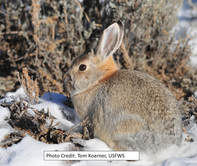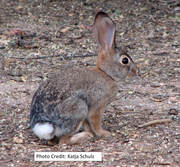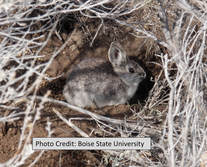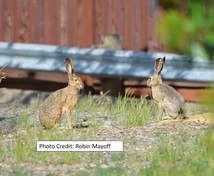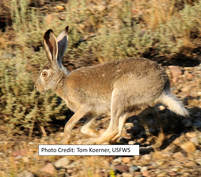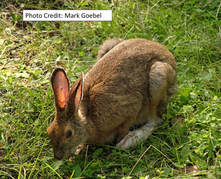Rabbits, Jackrabbits, and Tularemia
Featured Animal: July 2016
By Steve Zanoni and Dr. Nicki Frey
Cottontails and jackrabbits both come from the same family, Leporidae, and while they share many similar features due to their close relation, they are very different animals. Cottontails (Sylvilagus spp.) are considered true rabbits while jackrabbits (Lepus spp.) are actually hares. There are 2 species of cottontails and 2 species of jackrabbits in Utah: the mountain cottontail (S. nuttallii) and the desert cottontail (S. audubonii), the black-tailed jackrabbit (L. californicus) and the white-tailed jackrabbit (L. townsendii). Utah is also home to the pygmy rabbit (Brachylagus idahoensis), which looks like a small cottontail, and the snowshoe hare (L. americanus).
Featured Animal: July 2016
By Steve Zanoni and Dr. Nicki Frey
Cottontails and jackrabbits both come from the same family, Leporidae, and while they share many similar features due to their close relation, they are very different animals. Cottontails (Sylvilagus spp.) are considered true rabbits while jackrabbits (Lepus spp.) are actually hares. There are 2 species of cottontails and 2 species of jackrabbits in Utah: the mountain cottontail (S. nuttallii) and the desert cottontail (S. audubonii), the black-tailed jackrabbit (L. californicus) and the white-tailed jackrabbit (L. townsendii). Utah is also home to the pygmy rabbit (Brachylagus idahoensis), which looks like a small cottontail, and the snowshoe hare (L. americanus).
Animal |
Size |
Weight |
Distinguishing Marks |
Diet |
Location |
Activity |
Mountain Cottontail |
12-14 Inches |
1-3 lbs |
Ears 2-2.5 inches; brown-grey |
Grasses; sticks and twigs in winter |
>6000ft. elevation |
Nocturnal |
Desert Cottontail |
12-15 inches |
1-3 lbs |
Ears 3-4 inches; pale grey |
Grass, sagebrush; sticks and twigs in winter |
<6000ft. elevation |
Late Afternoon |
Pygmy Rabbit |
8-11 inches |
0.5 - 1 lb |
No puffy white tail |
Grass, sagebrush |
Western Utah sagebrush |
Nocturnal |
Black-tailed Jackrabbit |
17-24 inches |
3-7 lbs |
Ears 6-7 inches; black-tipped ears |
Grasses, buds, bark, twigs |
Most common in SW Utah |
Nocturnal |
White-tailed Jackrabbit |
18-22 inches |
5-10 lbs |
Ears 5-6 inches, White tail year-round; turns white in winter |
Grasses, buds, bark, twigs |
Common in northern and eastern Utah |
Nocturnal |
Snowshoe Hare |
13-18 inches |
2-4 lbs |
Ears 3-4 inches; feet white in summer; body turns white in winter |
Grasses, buds, bark, twigs |
Forested, mountainous areas |
Nocturnal |
There are many differences between rabbits and hares (Table 1). Rabbits, overall, are smaller in size, have shorter ears, smaller hind feet and are shorter in length than hares. White-tailed jackrabbits and snowshoe hares molt into white fur during the winter months while a rabbit’s fur retains its color throughout the year. Rabbits are known to hide and nest underground in burrows while hares prefer to settle into small depressions on the surface and run from predators rather than hiding. Since rabbits live underground in burrows their young are born “altricial”, free of fur, blind and helpless, needing to be cared for by their mothers for several weeks. Young hares on the other hand are born “precocial”, fully covered with fur, able to see, able to move completely on their own not long after birth. Rabbits are more social creatures, living in groups or colonies while hares live mostly on their own. Their diets are also rather different, while both rabbits and hares will eat green vegetation like grass and flowers, hares’ diet also includes buds, bark, and twigs.
Photo comparison of the different rabbits in Utah
Photo comparison of the different hares in Utah
Conflicts with Humans
Most conflicts with rabbits and hares involve them feeding on vegetables in the garden, plants growing in a landscaped area, or other areas where plants have some significant value. Cottontails are common garden pests in some parts of Utah, eating leafy greens and ruining crops. Cottontails and hares can also cause damage to fruit trees and landscaping by eating the bark and small branches in the winter and terminal buds in the spring. Methods to prevent damage from rabbits and hares include excluding, repelling, or removing the animal.
Methods to Exclude
Tularemia is a disease caused by infection from the bacteria Francisella tularensis. Rabbits, hares, and rodents are vulnerable to the disease and a large portion of a population can die during outbreaks of the disease. Rabbits and hares are the main host species for tularemia in North America. In the wild, the pathogen is inhaled; the infected animals’ bronchi, lungs, spleen, liver, and lymph nodes will show lesions.
Humans may become infected by:
References
Bowers, N., Bowers, R., and Kaufman, K. (2004). Field Guide to Mammals of North America. Houghton Mifflin Company, New York: New York.
Center for Disease Control and Prevention. (2015). Tularemia.
Conover, M. R., and R. M. Vail. 2015. Human diseases from wildlife. CRC Press, Taylor & Francis Group, Boca Raton, Florida, USA.
McAdoo, J. K. and J. A. Young. 1980. Jackrabbits. Rangelands. 2 (4):135-138
Mitchell, D. L., and Klimack, P. (n.d.). Biology and ecology of Utah rabbits and hares.
Link, R. (2004). Living with wildlife: Rabbits.
Rush, D. H. 1965. Some Movements of Black-Tailed Jackrabbits in Northern Utah. (Thesis) Utah State University, Logan, Utah, USA.
Most conflicts with rabbits and hares involve them feeding on vegetables in the garden, plants growing in a landscaped area, or other areas where plants have some significant value. Cottontails are common garden pests in some parts of Utah, eating leafy greens and ruining crops. Cottontails and hares can also cause damage to fruit trees and landscaping by eating the bark and small branches in the winter and terminal buds in the spring. Methods to prevent damage from rabbits and hares include excluding, repelling, or removing the animal.
Methods to Exclude
- Mesh Fencing- Most small gardens and individual trees can be protected from rabbits and hares by simple fencing.
- To exclude rabbits and hares from gardens, use a 1-in mesh chicken wire (woven wire) fence, and surround the area with a fence at least 2 feet tall, and a minimum of 6 inches underground, to prevent burrowing.
- To prevent damage to the bark of trees, surround each tree with a 1-in mesh chicken wire or woven mesh (hardware cloth). The fence should be taller than a rabbit or hare could reach on their back legs in the snow. Often a 3.5 ft. tall fence will be adequate. The surround should be buried 3 inches underground and stand out from the tree at least 1 inch.
- Solid barrier “fencing” – This method is often used when home owners want to protect several individual trees. These barriers should be 3.5ft tall to exclude jackrabbits. There are many commercial “tree wraps” and “tree shelters” that are effective at excluding most trunk damage from browsing rabbits and hares.
- Scare tactics – An animal’s natural fears can be used as a preventative measure against garden or tree damage.
- Mylar tape or Mylar party balloons can be placed above the area where damage occurs along with pinwheels and other wind moved devices can be placed on the ground around the garden or orchard. The effectiveness of using Mylar tape and balloons is variable, and may only work for short periods of time, if at all.
- Dog owners may use their pets to discourage rabbit and hare activities by keeping them outside in the yard at night. This is not a suggested method for discouraging browsing damage to trees during winter.
- Commercial and homemade repellants can be applied directly to and around plants, these are most effective when used prior to the start of damage, when new growth occurs or immediately after the start of browse. Repellants have variable success and are most often successful for only a limited time.
- Encouraging natural predators- many raptors prey on rabbits and hares, and providing perches for hawks and owls may help reduce damage.
- Rabbits and hares require cover from predators. Removing brush piles, thinning shrubs in fallow borders along your property, and otherwise removing possible cover from a property will reduce the attractiveness of your property.
- Shooting: The status of rabbits and hares as game animals vary by state. In Utah, the mountain cottontail, desert cottontail, and snowshoe hare may be hunted with a permit, during a specified hunting season. Jackrabbits are not considered game animals, and may be hunted without a permit. Pygmy rabbits may not be hunted during any portion of the year (UDWR 2016). Discharging a firearm within municipal boundaries is considered illegal in most states. Therefore, controlling rabbits using a firearm is not permissible in most situations.
- Toxicants: There are currently no toxicants registered for use to control rabbit or jackrabbit populations in Utah.
- Live Trapping: Trapping and relocating rabbits and hares is not recommended in most areas of Utah. When animals are trapped, humans may be exposed to any diseases they might have. Additionally, relocating the animal could relocate a disease into a new area.
Tularemia is a disease caused by infection from the bacteria Francisella tularensis. Rabbits, hares, and rodents are vulnerable to the disease and a large portion of a population can die during outbreaks of the disease. Rabbits and hares are the main host species for tularemia in North America. In the wild, the pathogen is inhaled; the infected animals’ bronchi, lungs, spleen, liver, and lymph nodes will show lesions.
Humans may become infected by:
- Being bitten by an infected tick or deer fly
- Skin contact with an infected animal
- Inhaling the bacteria
- Drinking water contaminated by the bacteria
- Use gloves when handling any rabbits and hares.
- Use eye protection when butchering rabbits and hares.
- Avoid any animal that appears to be infected.
- To minimize tick bites, use insect repellant when walking in fields, particularly where one knows rabbits and hares are living.
- An ulcer at the site of the tick bite, or where the bacteria entered the body
- Swollen lymph glands
- Fever
- Chills
- Loss of appetite
- Fatigue
- Headache
- Muscle aches
References
Bowers, N., Bowers, R., and Kaufman, K. (2004). Field Guide to Mammals of North America. Houghton Mifflin Company, New York: New York.
Center for Disease Control and Prevention. (2015). Tularemia.
Conover, M. R., and R. M. Vail. 2015. Human diseases from wildlife. CRC Press, Taylor & Francis Group, Boca Raton, Florida, USA.
McAdoo, J. K. and J. A. Young. 1980. Jackrabbits. Rangelands. 2 (4):135-138
Mitchell, D. L., and Klimack, P. (n.d.). Biology and ecology of Utah rabbits and hares.
Link, R. (2004). Living with wildlife: Rabbits.
Rush, D. H. 1965. Some Movements of Black-Tailed Jackrabbits in Northern Utah. (Thesis) Utah State University, Logan, Utah, USA.
